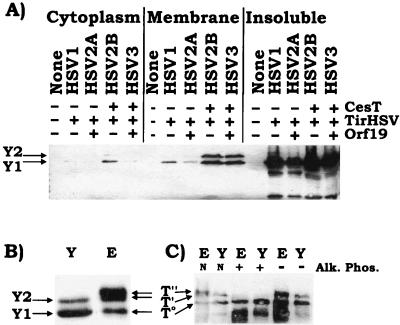FIG. 5.
Yersinia-directed delivery of TirHSV into host cells is independent of Orf19 and CesT, with the latter acting as an efficiency factor. (A) YPIII/pIB29MEKA (YE/HMEKA) strains, with or without the tir region plasmids, were use to infect HeLa cells. pSK-HSV1 carries tirHSV alone, pSK-HSV2A carries orf19 and tirHSV, and pSK-HSV2B carries tirHSV and cesT, while pSK-HSVs carries all three genes (Fig. 4). Host cells were treated with trypsin-EDTA to degrade extracellular secreted proteins and then fractionated into saponin-released cytoplasmic, Triton-soluble membrane, and insoluble fractions. Samples were resolved by SDS-PAGE (6% polyacrylamide) for Western analysis and probed with anti-HSV antibodies. (B) 90°C-heat-resistant membrane fractions from Yersinia pSK-HSV3 (Y)- and EPEC Δtir/pSK-HSV3 (E)-infected cells were isolated for Western analysis probing with anti-HSV antibodies. (C) membrane fractions, isolated as in panel B were left untreated (N) or incubated in the presence (+) or absence (−) of alkaline phosphate (Alk. Phos.) prior to Western analysis probing with anti-HSV antibodies. The positions of the Yersinia (Y1 and Y2)- and EPEC (T0, T′, and T")-delivered TirHSV species are indicted with arrows.

